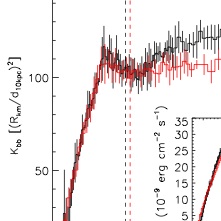Long bursts and the neutron star EOS
 Regular, mixed H/He thermonuclear bursts have long served as valuable comparisons for
numerical ignition models. Such bursts are observed only from a few systems,
and it remains a mystery why this mode of bursting is so rare.
GS 1826-24
is well-known for it's consistently regular bursts, but similarly regular
bursts have also been observed from the long-duration (now quiescent) transient
KS 1731-26. These bursts may also serve as important test-cases for
understanding the burst X-ray spectrum and how it may be used to constrain the
neutron star EOS.
Regular, mixed H/He thermonuclear bursts have long served as valuable comparisons for
numerical ignition models. Such bursts are observed only from a few systems,
and it remains a mystery why this mode of bursting is so rare.
GS 1826-24
is well-known for it's consistently regular bursts, but similarly regular
bursts have also been observed from the long-duration (now quiescent) transient
KS 1731-26. These bursts may also serve as important test-cases for
understanding the burst X-ray spectrum and how it may be used to constrain the
neutron star EOS.
Recently Nathanael Lampe & I published
a paper examining the consistency of radius measurements
from samples of highly consistent, regular bursts. We found that the blackbody
normalisation (from which the radius can be determined) can vary significantly
between burst epochs. This may partly be attributed to variations in the
spectral correction factor fc during some bursts.
In parallel,
Michael Zamfir and
Andrew Cumming developed
a way to
constrain the surface redshift, and hence the neutron star mass and
radius based on these bursts. (I had done something similar on the bursts from
KS 1731-26 a few years ago with a 3rd-year student at Monash, Richard Linossi, but
Michael & Andrew took this approach much further). There remains a lot of
uncertainty about how best to extract meaningful measurements from bursts, but
we are beginning to better understand the systematics that affect this
approach. This is also timely as other groups have already derived mass and
radius constraints from KS 1731-26
(Özel et al.
2012).
Galloway & Lampe 2012 (ApJ 747, #75)
Zamfir et al. 2012 (ApJ 749, #69)
Labels: 2012, /neutron star EOS




